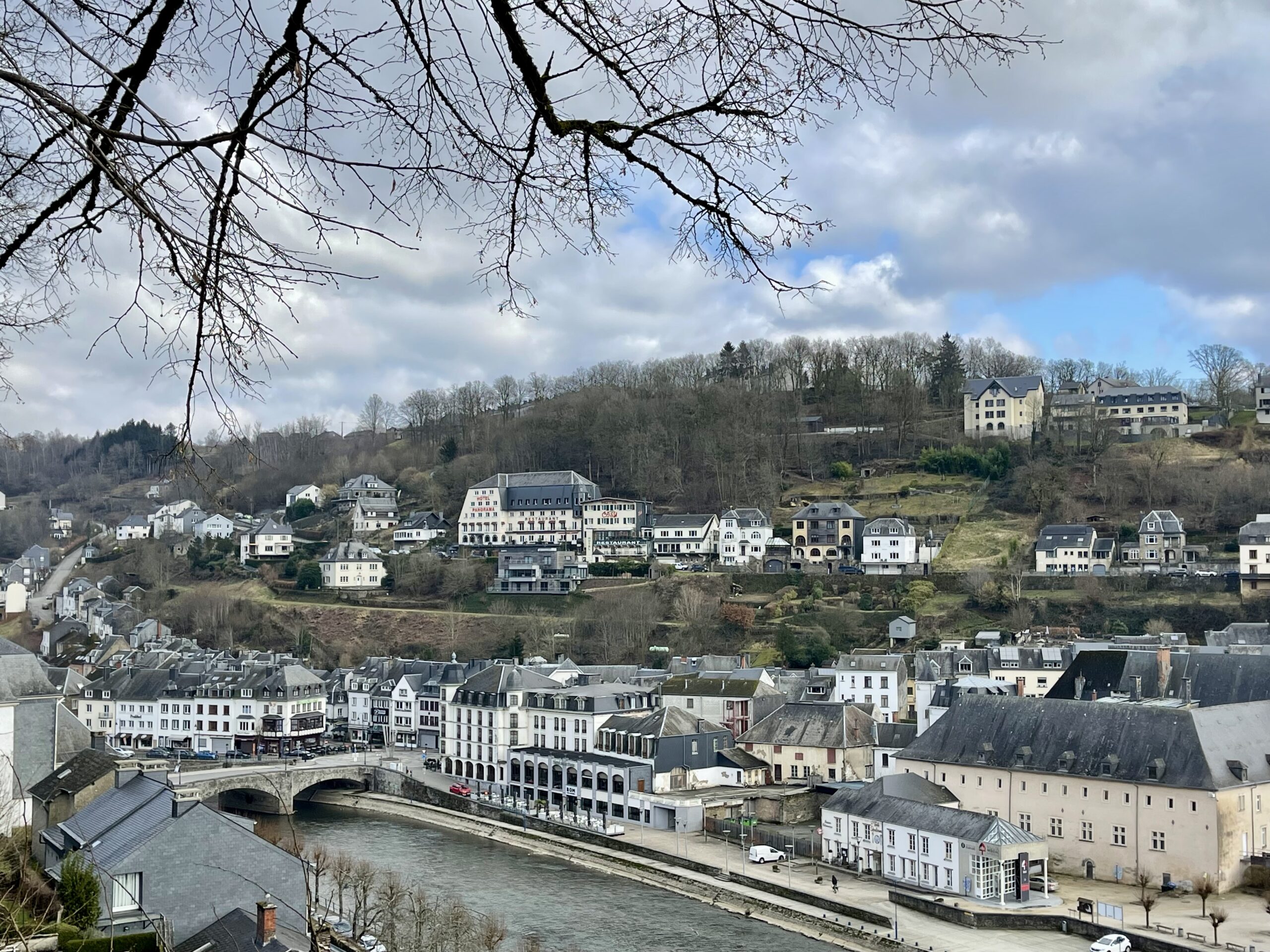In southeast Wallonia just 20km from the French border, Bouillon is a quaint, charming village known for Europe’s largest medieval castle. It also has stunning natural beauty due to its location along a meandering river in a green valley of the Ardennes.
While the name Bouillon differs from and much precedes that of the broth, incidentally, the village is defined by water “seasoned” with French heritage. (The proper noun comes from the Celtic word “bouillou” meaning “meandering river” whereas “bouillon” originates from the French verb “bouillir” as in “to boil”.) The Semois River semi-encircles the village, namely the Château Fort (Castle) de Bouillon, which was a symbol of France for centuries and home of legendary crusader Godefroy de Bouillon. The village is also defined by architecture of Louis XIV's military architect Sébastien Le Prestre de Vauban.
The image of Godefroy in Belgian history and his role in the crusades have been reviewed in modern historical research. For an account of Godefroy, between myth and reality, based on historical sources and interviews with historians, click here.
While Bouillon only has a population of about 5,300, it is lively due to a concentration of shops and eateries along the river as well as tourists, especially from April to September. The village caters to nature lovers who want scenic routes, good food and accommodation, plus it offers 20+ historical sights of interest. Flanked by three medieval bastions and slopes with thousands of trees, Bouillon enables steps back in time and in the moment in the Ardennes.
Bouillon does not have a train station so visitors must travel there by car (about 2 hours) or public transport (about 3 hours). The latter requires taking a train to Bertrix, Paliseul or Libramont then a bus to Bouillon.
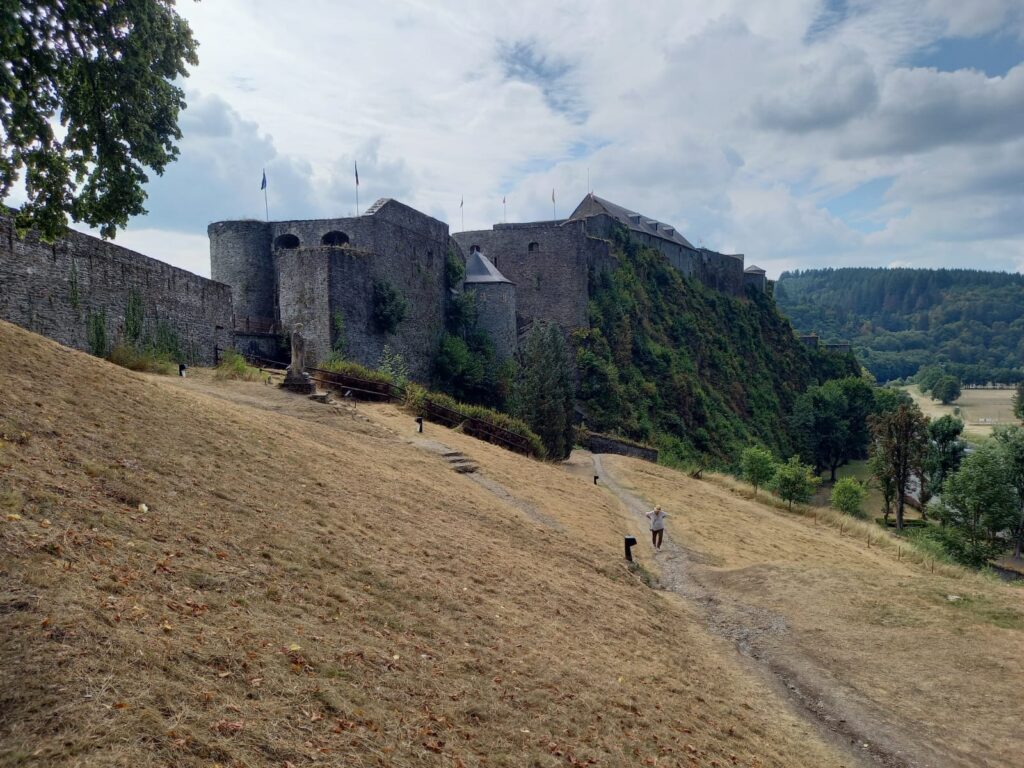
The castle in Bouillon, credit: The Brussels Times
Medieval Marvel
The 1,000-year-old Bouillon Castle is the “oldest vestige of feudalism in Belgium” and one of its most famous touristic sights. It is ideally located on a ridge surrounded on three sides by the twisting Semois River that forms a natural moat. The castle was built in 983 CE as property of the Lords of Bouillon, descendants from the House of Ardenne noble family, of which Godefroy of Bouillon was the last. He owned the castle until 1096, when he sold it to the then prince-bishop of Liège in order to finance the First Crusade to the Holy Land. Godefroy planned to reclaim the castle after conquering Jerusalem but he was poisoned there in 1100. So the prince-bishops of Liège retained control of duchy for almost six centuries.
In the early 16th century, a noble French family (De La Marck) stripped these dukes of their titles by usurping Bouillon. The buildings at the castle today date from this period. In the late 17th century, the duchy was fortified by Vauban, who redesigned the castle for heavy artillery as a protectorate of France. Through marriage and succession, another noble French family (La Tour d'Auvergne) took over the duchy until the end of the 18th century, when it became fully integrated into the French Republic (later the French Empire). But the Battle of Waterloo in 1815 put Bouillon under the Netherlands’ rule until Belgium gained independence in 1830.
The well-preserved, 20,000 square-metre, multi-story castle was attacked 17 times over the centuries but never destroyed. Primarily used as a watchtower and for tax purposes, it has several buildings, rooms, look-outs, ventilation/talking holes, a clock tower, deep well, 300 stairs and even an active cheese cellar. A stone staircase designed by Vauban amazingly holds together by force. Napoleon III gifted the clock on the tower when he visited Bouillon in the mid-1800s. The biggest room was for Godefroy of Bouillon, which later served as an indoor horse stable. The floor above it was used as a hospital in the 19th century; the walls prove it with scribblings from patients. Today, this room aptly hosts a permanent exhibition called “Scriptura” about the history of writing utensils. From there one can access a temporary exhibition of silk paintings and the tower rooftop with spectacular panoramic views of the village by day and night.
Outside the castle on its back side is an original white sculpture of Godefroy (a copy of it is in his former room in the castle and in Brussels, there is an equestrian statue of him in the middle of Place Royale). Near this sculpture is a small, dry moat and stone with streaks of white quartz called “fairy hair”. Pedestrians can access the castle via outdoor staircases on both sides or by car.
Self-guided and guided tours are available in several languages. Three times a day in the castle courtyard is a falconry show with several types of birds from small owls to actual falcons (two of which are comically named Philippe and Mathilde). At night, there is a guided torchlight tour inside the castle year-round and an “Odyssey of Light” show on its courtyard walls April to mid-Nov. The torchlight tour is especially spooky with the sound of wolves at the Parc Animalier (Zoo) de Bouillon in the background. This tour is available in French, Dutch and upon private booking, English and German. The castle also hosts special events year-round, including a Medieval Fest, gourmet walk, classical concerts, and hunting, trout and cheese festivals.
Triumvirate of Tourism
The Bouillon City Pass (12 Nov.-31 March) offers a discount on entry to the village’s three major attractions: the castle, Bouillon Medieval Experience and Musée Ducal. The Bouillon City Pass+ (1 April-11 Nov.) also includes a ticket to the evening “Odyssey of Light” show.
The Bouillon Medieval Experience, called the Archéoscope prior to renovation a year ago, is a high-tech sound and light show depicting Godefroy and the First Crusade. It on the second floor of the former Convent of the Sépulcrines dating to the 17th and 18th centuries. (The Tourist Office of Bouillon is in front of it on the ground floor.)
Musée Ducal covers the history of local life from medieval times to the 20th century, including displays of art, folklore, prints, arms and iron works (post-World War II, Bouillon was the country’s hub for ironmongery until the 1970s). It also has temporary exhibitions by regional artists. The museum is located in two buildings: the former Hôtel Spontin and residence of the Duchy of Bouillon's Governor, which are connected via an outside staircase. A striking artwork, “Écriture de Lumière”, made of gold paint is just outside of the old hotel building.
Military Memories
Around the Castle of Bouillon was a fortification wall with 12 pentagon-shaped bastions(projecting parts used for watching and defence) built in 1680 under French architect Vauban. Three remain intact and were renovated in the 20th century. Boulevard Vauban goes through two of these bastions and the third, Bastion de Bourgogne, oddly sits between two tennis courts. It is used a private tennis club bar (supposedly, the last “bastion” of hope to save it from demolition) and for occasional art exhibitions.
The route to each bastion is beautiful along the left bank of the Semois River, partly lined by trees. It goes past former military barracks (now an elderly home) and memorial monuments to locals who died in wars and 20th century actress Madeleine Ozeray.
The Liège Bridge in the centre of Bouillon originated in 1096. Few bridges existed then so it was an important crossroad of power between the bishops of Liège and Reims. Similarly, it was critical for German troops during World War II so it was bombed (and later restored). Bouillon was the home of Nazi collaborator Léon Degrelle, founder and leader of the Rexist (fascist) Party of Belgium. Rexist commandos killed a local pharmacist, Henri Charles Bouillon, for whom there is a memorial plaque on the Grand Rue near the bridge.
Behind the Ducal Museum is Le Quartier de Bretagne – named after soldiers from Brittany who lived in the area during the Vauban period – with 17th and 18th century buildings spared in World War II. It also has a covered passageway with historical information and displays, such as antique iron moulds.
A self-guided Historic Tour of Bouillon is available by mobile app. It begins in front of the tourist office.
Other Sights of Interest
Across the street from the third bastion is an impressive stone sculpture called “Deux Semois”that has a cut-out shape of the river through which one sees the actual river. The artwork was created by local Jean-Paul Couvert, who also made cigars from locally grown tobacco until early 2025. (Bouillon was known for cigars from the 18th century until World War II because tobacco grows well in the region. But after the war, cheaper U.S. cigarettes displaced cigars.) The sculpture is near the picturesque Cordemois bridge.
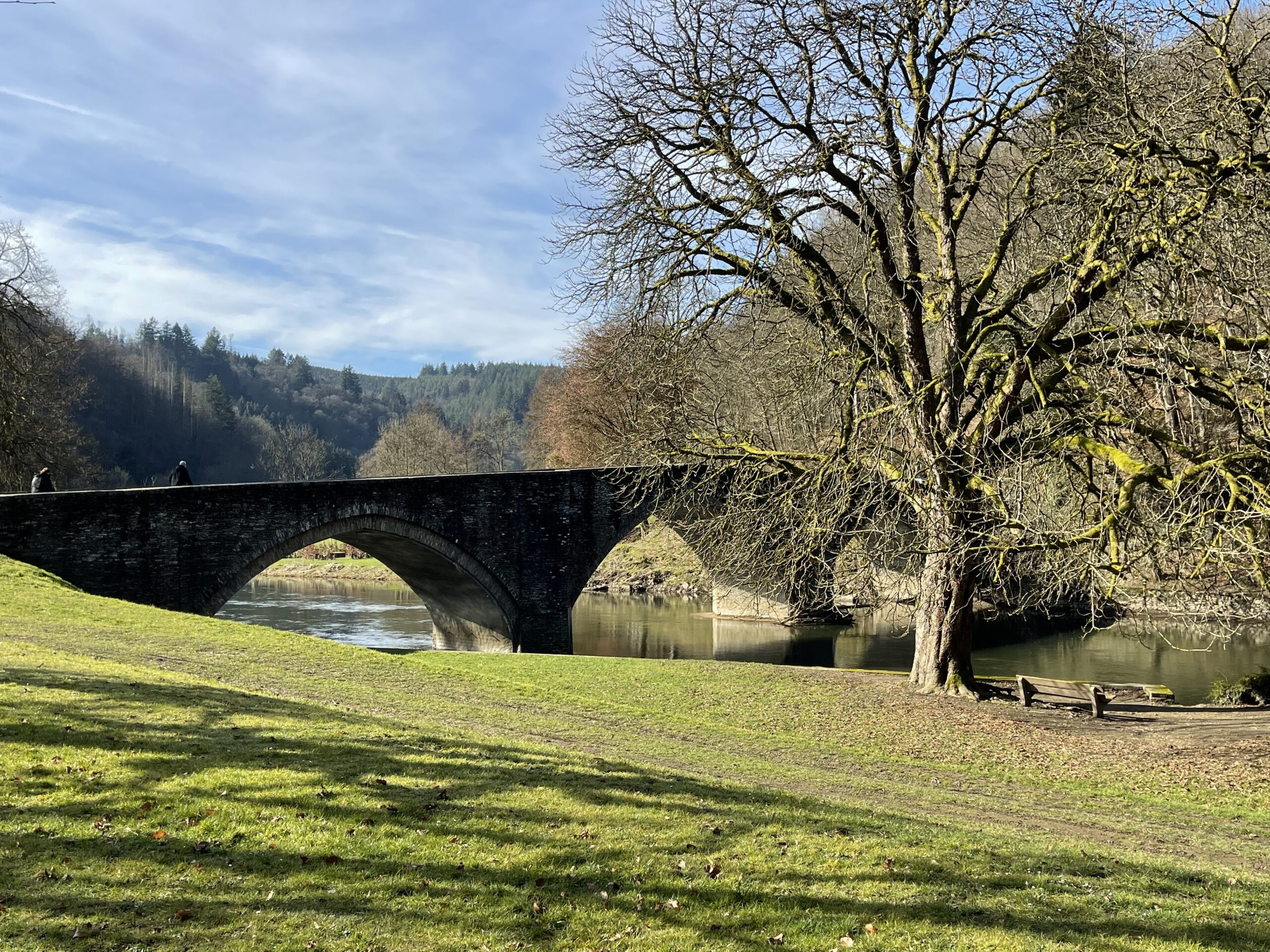
Cordemois Bridge.
The beautiful Paroisse des Saint Pierre et Paul church is made of golden sandstone. Inside it has impressive stained glass windows with geometric designs, a wooden pulpit and photo exhibition of the Procession of St. Eloi. The latter is an annual cake walk celebrating the patron saint who protected iron workers. Bundt cakes made by local bakeries in iron pans are stacked on poles and transported around the village via stretchers and baskets. The hour-long procession ends at the church where they are blessed and distributed to people who bought “shares” of them the week before for charity. In front of the church is a 2023 memorial in honour of the Bataillon de Chausseurs Ardennais (Battalion of Ardennes Hunters), a light infantry that helped defend the area in the 1930s-40s, namely during the German invasion.
The 1935 Notre-Dame de Clairefontaine Abbey is also striking as it’s situated on a former farm. It is home to Cistercian nuns who share part of their secluded house and garden with guests seeking peace and silence.
Friendly tourists may be able to see the charming ground floor of a private home that’s designed like an Art Nouveau café at Grand Rue 8. Above the entrance is a misleading sign that says “Café des Arts”. Owned by local Christian Danloy, the “café” is a former jewellery shop full of antique artifacts like a museum. He often has the door open and welcomes individual visitors.
The Euro Space Center in the village Transinne 27km from Bouillon offers simulated astronaut training, including aptitude tests, simulators, space travel and even a visit to a Martian village.
Nurture by Nature
Bouillon municipality is nestled within Semois Valley National Park, which spreads nearly 29,000 hectares over eight municipalities with 687km of waterways. The vast majority (92%) of the municipality is uninhabited, providing plentiful green space, viewpoints and trails.
Two must-see viewpoints are Panorama du Belvedere in nearby Curfoz and the Tombeau du Géant (Giant’s Tomb) in Botassart. The panorama has a multi-story look-out tower with spectacular views of Bouillon and the Semois River. The Giant’s Tomb is a unique hilly island encircled by the river. It is 10km from Bouillon and accessible by foot or car.
Other scenic hiking trails are the way-marked Promenade de la Sente aux Geais (3.5km, route 9), which begins at the tourist office and follows a historic tram route, and Promenade de la Ramonette et Arboretum (5km, route 8), which goes from near Bouillon Tunnel behind the castle up to the Vue (Viewpoint) de la Ramonette above the castle and then to the Bouillon Botanical & Geographical Arboretum. Created in 1906, the arboretum features 150+ native species plus exotic plants and trees.
About 20km from Bouillon, the lively village Rochehaut features the beautiful Point de Vue de Frahan overlooking a tiny village on an island in the Semois River as well as Les Echelles de Rochehaut, ladder chutes to ascend steep, rocky parts of hiking trails. Auberge de Rochehaut has several restaurants for a mid- or post-hike bite or drink.
Area hiking and biking maps are available at the tourist office along with information about an adventure park, segway tours, horseback riding, and kayak and pedal boat rentals. The impressive Viaduc de Conques over the Semois River is a highlight kayaking. For the exercise-challenged, there is a kitschy tourist train, Le P’tit Train de Bouillon, which goes past major attractions and stops at the animal park.
Tastes of Bouillon
The most unique foods in Bouillon are L’Oeillet du Château, hard cheese made from unpasteurised goat milk that’s aged in the castle cellars, and Le Croisé, a low-sugar, Speculoos-like biscuit that bears the image of Godefroy. The cheese, named after a little pink carnation that grows around the castle, is made by Bergerie d'Acremont according to a medieval recipe. Le Croisé was created in 1996 to celebrate the 900th anniversary of the First Crusade. The biscuits are sold in a metal box depicting Godefroy and the castle.
Abundant Semois River trout is also worth tasting along with smoked Ardennes ham and dry sausages. Every April is La Fête de la Truite (Trout Festival) when local restaurateurs serve the fish in a variety of preparations. Another favourite local dish is Civet de Sanglier, wild boar stewed with white wine and ginger.
Craft beer is perhaps the hottest regional commodity. Regional breweries include Brasserie Maziers (which makes Godefroy de Bouillon beer of the castle) and Brasserie de Bouillon (known for its brown beer called La Bouillonnaise) in Sensenruth as well as Brasserie de Rochehaut in the village of the same name. World renown Orval beer is made about 60km from Bouillon in Florenville by Trappist monks. Its name is credited to the aunt of Godefroy, who – according to legend – lost her gold wedding ring in the Semois River, which was miraculously retrieved by a trout. The ring-bearing fish thus became the symbol of Orval, meaning “golden valley”, and the countess established a monastery on the site.
Other local beverages include Élixir du Château, a liqueur made from 30+ plants and aromatic herbs; its eau de vie equivalent Ésprit du Château; and Semois Gin made from regional plants, such as mistletoe, wild garlic, pine, peppermint and the castle carnation.
Experience
La Fête Médiévale: A two-day medieval festival every August at Bouillon Castle, featuring craftspeople, knights, fire-eaters, troubadours, falconers and minstrels, 9-10 Aug. 2025
Les Musicales de Bouillon: Two days of classical music concerts at the foot of the castle every August, with fireworks on the second night, 16-17 Aug.
Marché Gourmand de Bouillon: A 10km walk each September with eight gourmet stops featuring local artisans, starting with breakfast at the castle, 14 Sept.
Fête du Fromage: An annual autumn tasting of L’Oeillet du Château goat cheese in Bouillon Castle, 20-21 Sept.
Halloween au Château fort de Bouillon: An annual three-day “haunting” of the castle with friendly “ghosts” for kids and scary ones for adults, 31 Oct.-2 Nov.
Procession of St. Eloi: A “cake walk” every first Sunday of December in honour of St. Eloi, who protected iron workers, 7 Dec.
Savour
L’Artiside: A centrally located bistro and brasserie serving French-Belgian cuisine amidst a red and black décor
La Ferronnière: In the hotel of the same name, a gourmet restaurant serving contemporary cuisine in a romantic setting on a hill
La Table de Maxime: A two-star Michelin eatery by Chef Maxime Collard featuring modern French cuisine in an old farmstead in the village Our
La Table des Sépulcrines: Located next to the tourist office, a cosy, gastronomic brasserie serving Belgian and French cuisine
Panorama: A modern, bright restaurant with 3-5-course seasonal menus and beautiful views in the hotel of the same name
Sip & snack
Benoît Michels: A centrally located bakery that makes Le Croisé biscuits and has an upstairs tearoom with beautiful views of the Semois River
BOM Food and Drinks: A casual indoor-outdoor restaurant with a well-placed terrace alongside the Semois River that’s ideal for a local beer or other drink and seasonal bites.
Le Parchemin: A cosy, elegant tearoom with indoor-outdoor seating and knick knacks that’s perfect for a glass of wine
Philippe Legrand: An upscale bakery making buttercream-filled waffle sandwiches, beautiful desserts and more
Pierre Gigot: An artisanal ice cream maker who uses farm-fresh milk and fruit, producing various flavours and waffle cones visibly on site
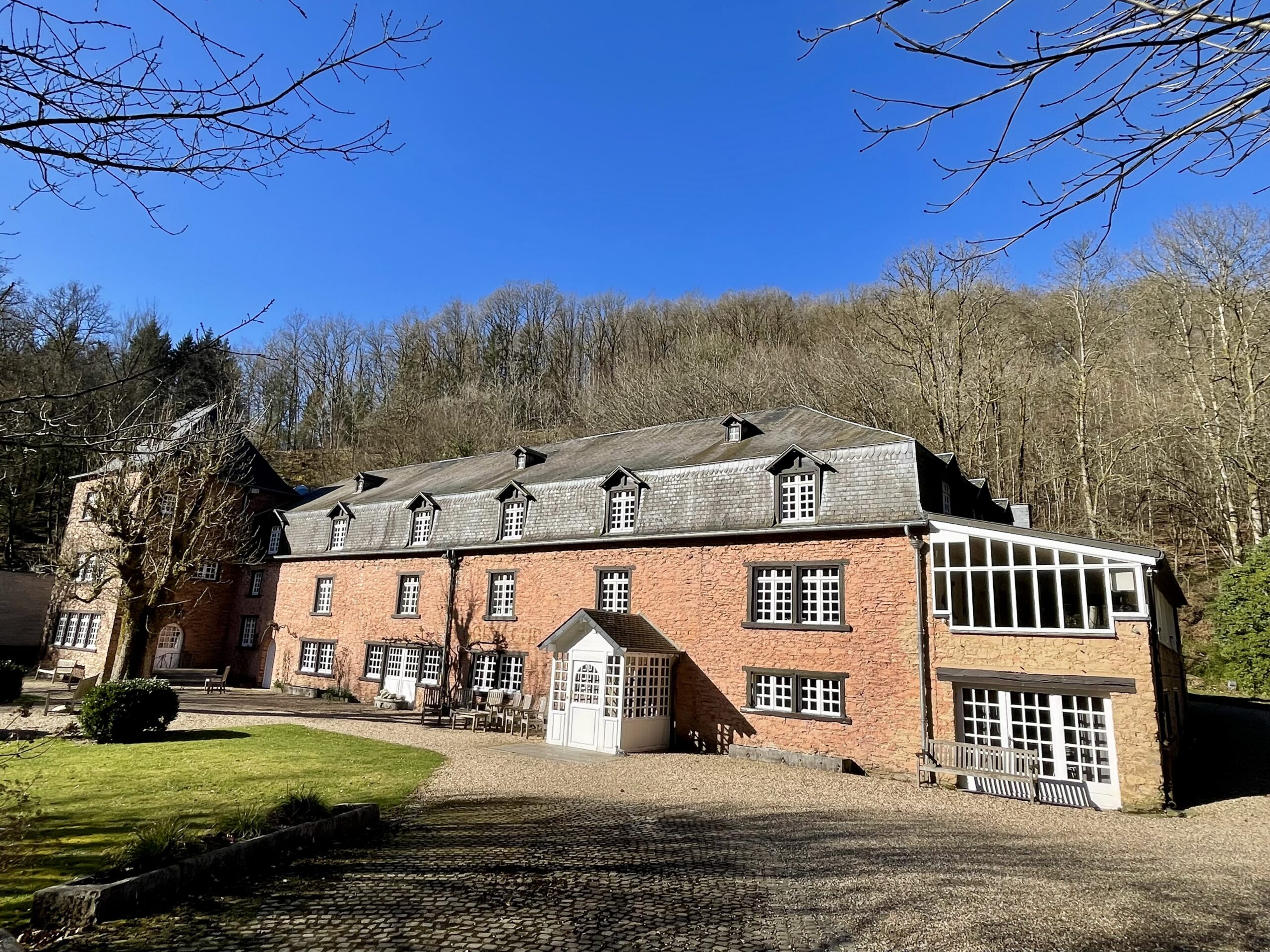
Auberge du Moulin Hideux.
Stay
Auberge du Moulin Hideux: A former mill that’s now a charming 12-room residence for rent, including a terrace and indoor pool, nestled in nature 10km from Bouillon centre
Hotel de la Poste: Ideally located in the centre of Bouillon and known for once hosting Napolean III, this Old World hotel has modern rooms, a breakfast buffet with outstanding croissants and three restaurants
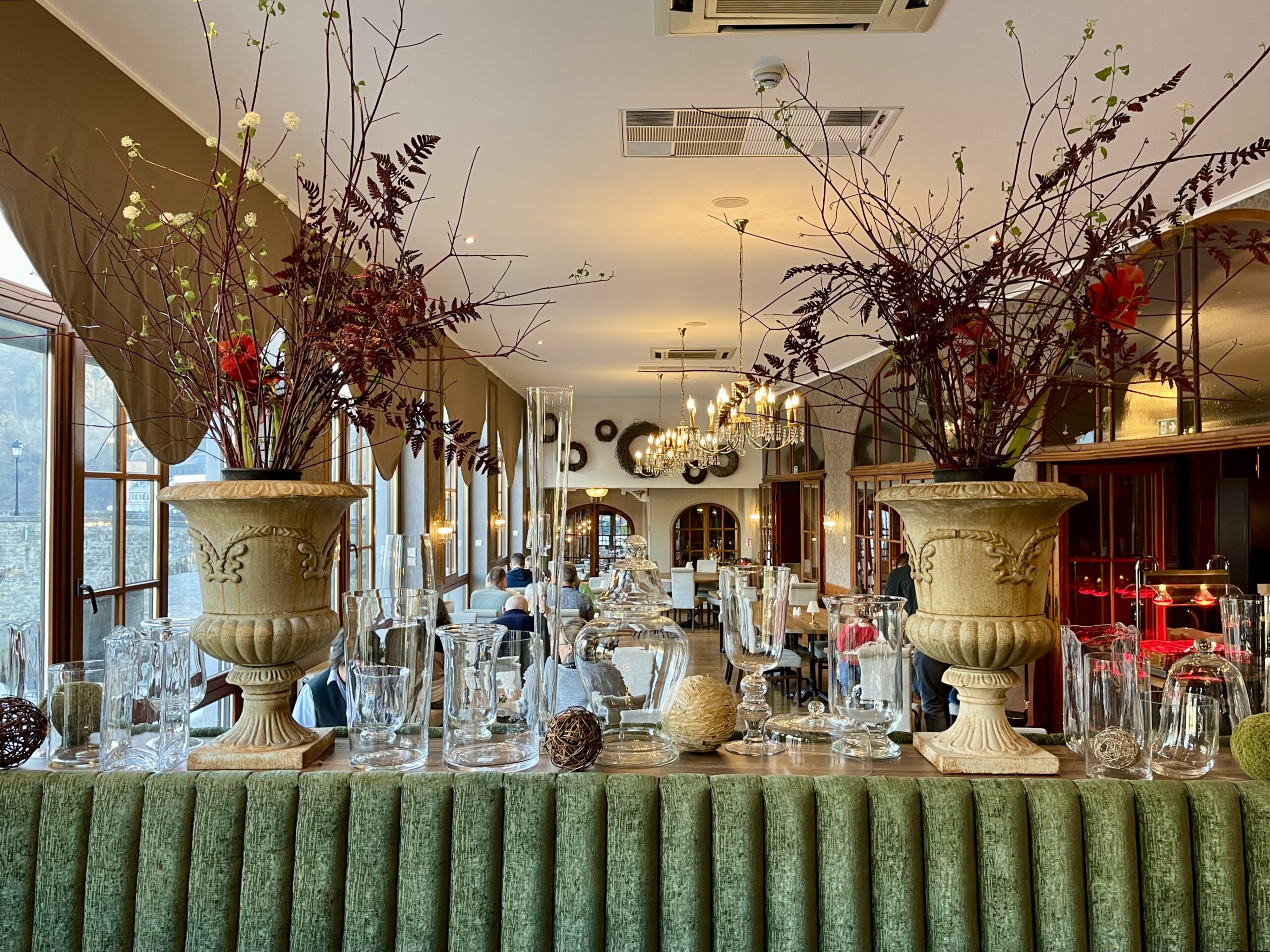
Hotel de la Poste.
Hotel Panorama: A modern, bright hotel on a hill with spectacular views, 25 stylish rooms, a bar, restaurant, terrace, and private pool/jacuzzi for rent
La Ferronnière: In the former home of an iron manufacturer, this beautiful, hill-side hotel has 13 rooms, a breakfast buffet, restaurant and spa
Les Lodges de la Vierre: Fourteen wooden lodges for 2-6 people each with a covered terrace, jacuzzi and pontoon boat, located on Domaine de Waillimont, a 25-hectare oasis including a tributary of the Semois River, in the commune of Herbeumont about 25km from Bouillon
Shop
Bouillon Medieval Experience: A shop next to this show’s ticket desk sells local beers, spirits, Le Croisé biscuits, and handmade soaps and candles
Boucherie Ponceet: A butcher with Ardennes sausages and smoked ham
Boulevard du Chocolat: Sells chocolate pralines and bars handmade in the region
Savonnerie du Tuc de Bouillon: A soap maker in nearby Sensenruth selling artisanal soaps, candles and more
Le Tabac Semois: A cigar-making shop, atelier and museum in the village Corbion, where owner Vincent Manil handmakes cigars with locally grown tobacco

